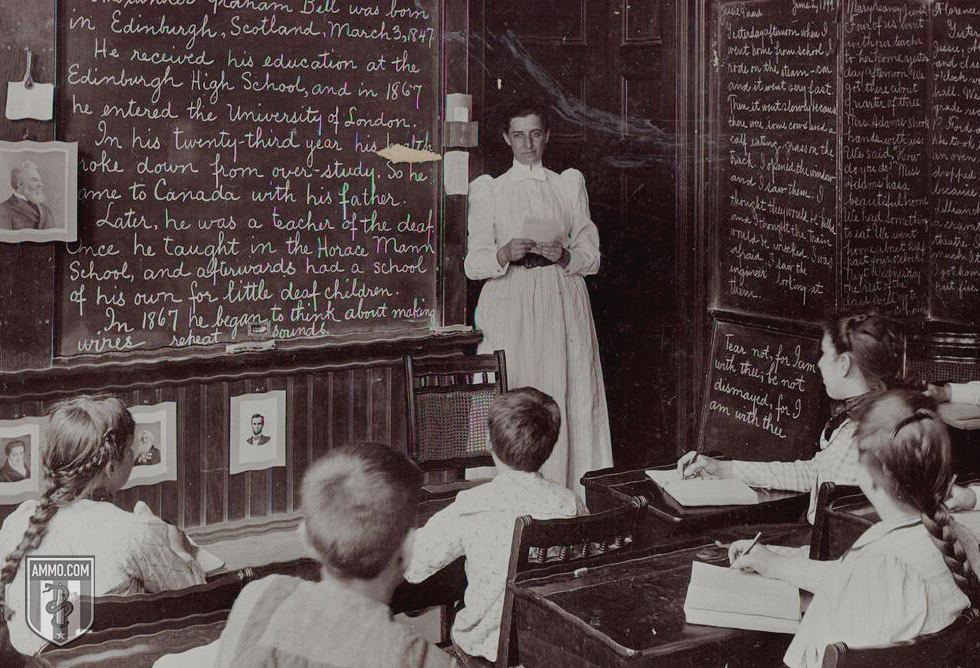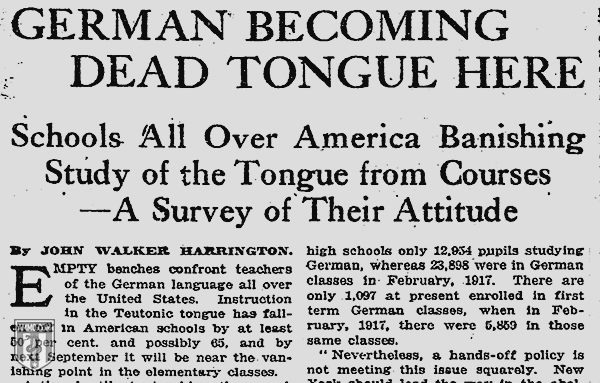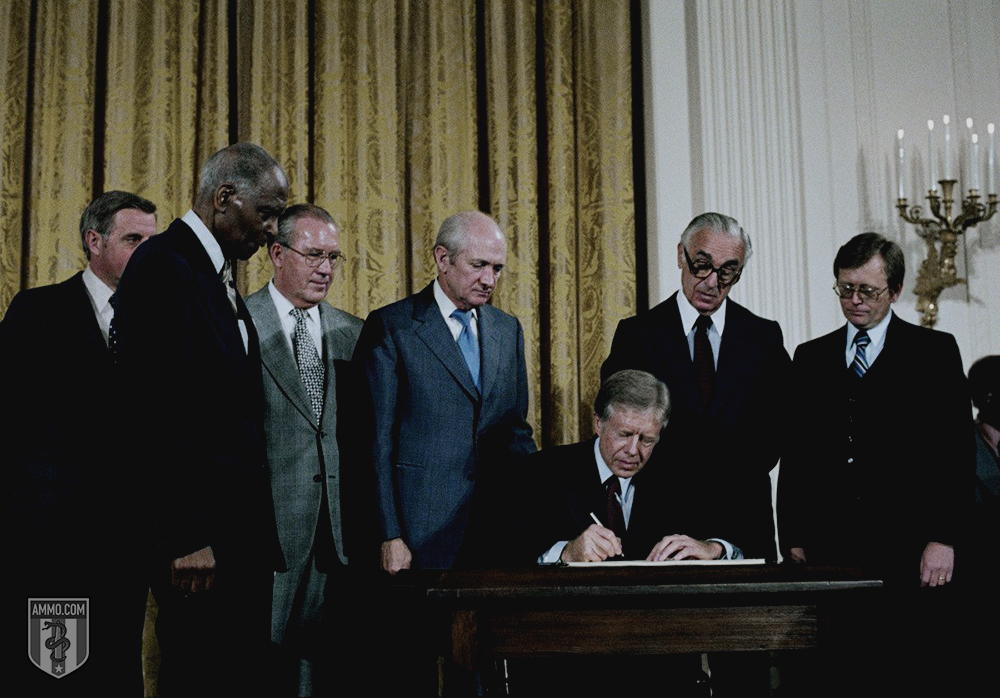The History of Private Schools: How American Education Became a Political Battleground
You're free to republish or share any of our articles (either in part or in full), which are licensed under a Creative Commons Attribution 4.0 International License. Our only requirement is that you give Ammo.com appropriate credit by linking to the original article. Spread the word; knowledge is power!
“He alone, who owns the youth, gains the future.”
Public schools are so ubiquitous and ingrained in American culture that one could easily be forgiven for thinking that we, as a nation, have always had them. However, public schools are a relatively recent invention. Federal funding for public schools is a recent anomaly, dating back to the days of President Jimmy Carter. His successor, President Ronald Reagan, famously tried to dismantle the Department of Education to no avail.
Public schools being an arm of the state are indoctrination centers. This becomes increasingly true as basic skills such as the old “three Rs” of “reading, writing and ‘rithmatic” are jettisoned in favor of climate change, critical race theory and gender ideology – all of which are now part and parcel of a public education in the United States. As if this weren’t troubling enough, public schools are largely funded by property taxes on housing. These taxes, which are paid generally on a bi-annual basis, are confiscated from people whose children do not even attend public schools. What’s more, these taxes require people to effectively pay rent on owned property under penalty of losing their homes.
We do not have to look far for an alternative to the world of public schools. Throughout most of American history, education has been the purview of parents, the church, and other private institutions. The rise of public education in the United States is a story of violence and coercion that is largely hidden from the public record. After reading this, you will never view public schools in the same light ever again.
Public vs. Private vs. Vouchers: How It All Works
Before we get into the meat of the matter, it is worth explaining some things about public education, private education, the voucher system, and how each of these works.
- 5.7 million students are enrolled in private schools, approximately 10 percent of all students in the K-12 system.
- Between the year 1991 and 2015, the proportion of non-religious schools in the United States has grown greatly, from 14.8 percent to 21.8 percent.
- Catholic schools are still the leader, but their market share has declined significantly from 53 percent to 38.8 percent.
- In 2016, 1.69 million children were homeschooled, making up 3.3 percent of all children of school age.
- This is an explosive growth from the year 1990, when only 250,000 children were educated at home.
- As of December 2016, there were 14 states with traditional school voucher programs.
- Other private market alternatives to school vouchers include tax credits and education savings accounts.
- When these are added into the picture, there are 27 states with some kind of educational choice program.
All told, 10 states provide vouchers for children to attend private schools as of 2019. Vouchers are either coupons directly paid to private schools or tax credits that reimburse parents at tax time. President Donald Trump has said that he wants to distribute $20 million in federal education dollars as block grants to states that would take the form of school vouchers.
The Pre-History of Public Schools in the United States
 Unsurprisingly, public education in the United States was primarily a regional phenomenon in the earliest days. New England was known as one of the first places with public schools. However, these were not “public” in the sense that we think of public schools today. First of all, the schools were not compulsory. While Massachusetts and other New England states did have compulsory education laws, these did not mandate the use of the public schools nor any other education method for that matter. They only required what was called “proper education,” which in many cases might not have included basic literacy.
Unsurprisingly, public education in the United States was primarily a regional phenomenon in the earliest days. New England was known as one of the first places with public schools. However, these were not “public” in the sense that we think of public schools today. First of all, the schools were not compulsory. While Massachusetts and other New England states did have compulsory education laws, these did not mandate the use of the public schools nor any other education method for that matter. They only required what was called “proper education,” which in many cases might not have included basic literacy.
In the South, tutors were the most common means of education for the planter class. During the colonial period, it was not uncommon for such upper-crust Southerners to send their children overseas to England and Scotland for their education at a boarding school.
For the most part, where people received formal education, it ended at eighth grade. Secondary education was not commonplace for the majority of Americans until the mid-20th century. According to A Cyclopedia of Education (4 vol. 1911), every state had some kind of publicly funded elementary school education by the year 1870.
Teaching was not a profession most sought out. It was mostly work for single women who lived in the school district. The primary qualification was knowing how to make the most out of the limited tax resources available to the schoolmaster. With the development of two-year normal schools (career academies for unmarried middle-class women), teaching became increasingly professional. There were now specified training academies for teachers. According to Jurgen Herbst in The Once and Future School: Three Hundred and Fifty Years of American Secondary Education, most public school teachers in Northern states had degrees from normal schools by the year 1900.
The important thing to note is that prior to the establishment of compulsory education in the United States, there was greater freedom for parents to determine how best to educate their children than probably anywhere else in history. Teachers were not required to have certificates. Licensing boards did not exist, nor did regulatory bodies.
Even in the early days of public education, there was much more freedom, even for those who attended public schools. The entire curriculum, as well as the person teaching it, were under the control of the local school board, not federal or colonial bureaucrats. Part of this flowed from the Puritan/Calvinist ethic. There was no central authority when it came to determining the meaning of The Bible. Nor was there any central authority for education, for many of the same reasons.
Upon the establishment of the United States, only one American city had a public education system, and it was not a “system” in any sense we would recognize today. First, it was not compulsory. Primary education was largely left to the private “dames schools.” Literacy was required to enter grammar school at the age of seven. What’s more, the trend was toward more private schools. Most people throughout the commonwealth preferred private schools, with the exception of Boston and it’s Boston Latin, which was widely respected as an elite education institution and feeder to Harvard University (which was founded in part with a public grant).
In 1818, Boston began its push to shutter the popular private schools and force the state’s children into compulsory, publicly funded schools. There was too much juvenile delinquency, and this was linked to a lack of compulsory education. A committee appointed a subcommittee (of course) and a survey of the state’s educational system was carried out. Here’s what it found:
- The eight public schools in Boston had 2,360 pupils.
- The 150 private schools shared over 4,000 pupils between them.
- Of children between the ages of four and seven, 283 children did not attend school.
- Of children over the age of seven, 243 attended no school.
A couple of extrapolations spring out from this. First of all, over 90 percent of Boston’s children were in some kind of school. What’s more, the private schools offered a much lower student-to-teacher ratio on average than the publicly funded schools. Finally, charity schools existed to cover the needs of pupils whose families could not afford either private or public schools, which, at that time, collected tuition fees in the same manner public universities and college do today.
The solution was not to provide subsidies for the children whose parents could not afford the public and private schools which already existed. Instead, Massachusetts embarked on the radical enterprise of forcing every child into the public school system – every child, that is, other than those who could afford to go to the elite private academies that were de rigueur for the bluebloods of Boston.
Screaming children were literally ripped from the arms of their parents and sent off to public schools. As if this were not horrifying and totalitarian enough, the new public schools of Massachusetts largely disseminated the Unitarian religious philosophy which had ousted Calvinism from Harvard in 1805. Further, they looked to the Prussian school system – centralized, with truant officers, grades and uniform curriculum – as their model for what public education ought to look like.
Thus, in 1852, Massachusetts became the first state to mandate compulsory education of children in primary school. New York became the second state in 1853. By 1918, all American children were required to go to school at least through eighth grade.
Private Schools: A Refuge from Statism
 Not everyone sent their children to the new public schools. However, it became increasingly more difficult to open private schools. Where once there were no regulations, now there were a host of regulations designed to make private education of children difficult and public education easy.
Not everyone sent their children to the new public schools. However, it became increasingly more difficult to open private schools. Where once there were no regulations, now there were a host of regulations designed to make private education of children difficult and public education easy.
An extreme example of this is when German-language schools were shuttered in the propaganda lead up to the United States’ entry into the First World War. At this time, Germans were the largest minority in the United States. What’s more, German was used as a lingua franca for members of both the Jewish and Austro-Hungarian diaspora living in the United States. Thus, many in the United States took part in public and private German-language schools.
In a real-life example of what a nationalization of education in the United States would look like, all of the German language schools were shuttered, state by state. This targeted not just German-language schools, but also German literature, German citizens’ associations and even the instruction of German in schools. In 1916, the number of students studying German was 25 percent. Five years later in 1921, a scant one percent of all schools taught German at all.
Many of the German-language schools were independent of the public school systems. At the outbreak of World War I, they were painted as a sort of Third Column for the German Empire. When they were shut down, they did not recover and an entire way of life went away with them – the rich German culture, which had existed in the United States since colonial times.
There is a more recent example of the government shutting down schools. After integration, there were a number of so-called “segregation academies” set up by parents who did not care for the quality of the newly integrated schools. Their existence was invalidated through both statute and court rulings, culminating in Runyon v. McCrary (1976), the Supreme Court decision mandating that private schools could not discriminate on the basis of race. Previously, activists had used the courts to remove the tax exempt status of schools using such criteria for admission.
None of this requires a moral defense of the positive value of segregation. It is simply to point out that, much like the shuttering of German language schools and so-called “segregation academies,” the shuttering of private schools will likely come with a heavy dollop of political witch hunt attached to it. View how the media began pillorying Second Lady Karen Pence as somehow bigoted and backward for teaching art at a private Christian school – quickly pivoting to targeting Covington Catholic’s students for the crime of smirking while white.
A movement against private schools and homeschooling in the United States will likely be coordinated by the government along with the corporate media, which acts as a sort of de facto official propaganda service.
A Brief History of the Department of Education
 The state’s mechanism for school takeovers is already in place – the Department of Education (DoE), created in a fairly transparent quid pro quo between then Democratic Vice Presidential nominee Walter Mondale and the National Education Association (NEA), the largest labor union in the United States. This was the first endorsement it had ever given for a presidential candidate, support that they renewed in 1980, when Carter ran for re-election against anti-DoE candidate and future President Ronald Reagan.
The state’s mechanism for school takeovers is already in place – the Department of Education (DoE), created in a fairly transparent quid pro quo between then Democratic Vice Presidential nominee Walter Mondale and the National Education Association (NEA), the largest labor union in the United States. This was the first endorsement it had ever given for a presidential candidate, support that they renewed in 1980, when Carter ran for re-election against anti-DoE candidate and future President Ronald Reagan.
One of Ronald Reagan’s most public and high-profile failures was his inability to destroy the DoE. There was very little enthusiasm for the creation of the Department of Education. However, there was virtually none – other than Reagan and his Secretary of Education appointee Terrel H. Bell – whose sole mission was to dismantle the Department and replace it with something more like the National Science Foundation.
Roughly 35 years later, the budget for the entire Department of Education stood at $70.7 billion in 2016. This did not include an additional $75 billion in pre-K education over the course of 10 years.
This is mostly spent on pushing a far-left agenda. The Mises Institute has thoroughly documented the 35 years of leftist bias at the DoE. Much of the civics curriculum is dedicated to a denunciation of America’s Founding Fathers, and a focus on slavery, racism and colonialism. The United States Constitution is not a core part of the curriculum. Great works of American literature are routinely barred in the public schools, including The Adventures of Huckleberry Finn, Moby Dick, and The Great Gatsby.
It’s worth briefly noting that the National Education Association is the largest union in the country and wields an enormous amount of power when it comes to education policy in the United States. After all, they got a cabinet-level department created. They have been effectively able to prevent merit pay for teachers – credentials count more than performance when calculating pay. In many states, union membership is effectively mandatory, in as much as teachers are bound by collective bargaining agreements.
Between 2004 and 2016, political donations by teachers unions grew from $4.3 million to $32 million. 94 percent of all contributions, going back to 1990, went to Democrats.
How Federal Education Funds Are Allocated
As one might expect, the entire process for allocating funds to schools is Byzantine and difficult to understand. All told, states and local schools aren’t really relying on federal funds to get kids educated – most of the money for public schools comes from pernicious property taxes, whereby the government effectively requires you to pay rent on property that you already own. Approximately 10 percent of state education budgets come from the federal government.
Funds aren’t allocated in any systematic way. They’re allocated on the basis of State Education Agencies (SEAs) filing what are basically grant requests from the federal government, based on anticipated “needs.” Some income formulas are used in this process, but they do not represent the whole of how funds are allocated. The SEAs allocate their funds largely on the basis of income, to what are called Local Education Agencies (LEAs). These agencies then allocate funds using no less than four different formulas based on income and census reports.
The final result is that money is allocated for schools in a manner that favors the least well performing. This is very much in keeping with the radical, left-wing, redistributionist agenda of the teachers unions. In the American public education system, there is simply no mechanism in place that encourages excellence. There is only a system which rewards mediocrity – the ability to pass a standardized test that, it’s assumed, “everyone,” from the smallest town in rural Mississippi to the ritziest neighborhood in Manhattan, ought to be able to pass at the same rates.
Some states allocate need based on a “per-pupil cost.” Perhaps somewhat unsurprisingly, the highest figure can be found in our nation’s capital: the District of Columbia gets $19,000 a head for its public school students. Some businesses exist to help school districts navigate this difficult process to get the biggest share of federal funds possible.
This is now the prerequisite to getting into college – passing the standardized test. It’s worth noting that the largest expenditure of federal funds on education is the Pell Grant, which has devalued a college education significantly while driving soaring tuition fees.
How Public Schools Indoctrinate
Beyond all their other problems, public schools are also a mechanism for indoctrinating children in far-left, anti-Christian and anti-American ideologies. While it’s often clear how this works in higher education, with its coterie of Marxist professors, it is less clear how it works in primary and secondary education. Indeed, many parents who are otherwise skeptical about the role of the government in their lives might not know that even the humble public elementary school is where the far-left indoctrination begins.
There is no shortage of extreme examples of this. For instance, four states currently require “LGBT history” to be taught. You can easily find curricula for teaching transgender ideology in elementary schools online. Elementary schools have likewise begun teaching young children about “white privilege” ideology. While all of these examples are extreme, they are worthy of note. California, because of its size, often determines what is taught in classrooms all across the nation, because textbooks must sell there. What’s more, what is taught in public schools in San Francisco and New York today will almost certainly be taught in your town in just a few short years thanks to the sheer “demand” (if we can even call it that) created by the captive public school markets in these areas.
However, there is a more important issue of the role that public schools play in indoctrinating children more generally than any one specific and extreme example. It is necessary to pull back a bit from the individual examples of our children being indoctrinated in values hostile to our own and be critical of the role that public schools play in indoctrinating children more generally.
First, we should talk about what we mean by “indoctrination.” This does not simply mean “teaching children things we do not like.” We mean imparting ideological information as knowledge without any regard for critical thinking skills. It is the latter part of this that is the most important: That critical thinking skills are not taught, but an agenda. The lack of thought is key: Young people are given a world view by another rather than working it out through their own reason using available facts.
The alternative to this is not introducing conservative or libertarian texts. This will only deepen the public education system’s role as a propaganda outlet and will mean more political football with public schools. What’s more, there is no reason to believe – that is, there is no evidence – that public schools can be anything more than indoctrination centers for the prevailing ideology of the time. No less an authority than John Stuart Mill opposed state education on these grounds.
We should note that it is not necessary to prove that all or even most teachers are actively pursuing a certain agenda. We must only note that the left-wing agenda has powerful proponents within the teachers union and the Department of Education.
We must also stress that the problem is one much greater than simply your children or another’s being indoctrinated with a hostile ideology. The problem is a social one that leads to entire generations not only vehemently opposed to Christianity, America and freedom, but also entirely bereft of the critical thinking and formal logic skills necessary to “think” their way out of the box.
To see the real-world consequences of this for society at large, one need only turn on the news. We are reaping the results of ideological indoctrination sown for the better part of the last 50 years.
Freedom of Education: In the United States and Abroad
 The United States enjoys a great degree of freedom of education when compared to other countries. This is particularly true in Continental Europe, where homeschooling is either extremely difficult, highly regulated, or completely verboten. In many cases, where private schools flourish and homeschooling is allowed, there are public resources available for those who choose to educate their children outside of the state-sponsored school system.
The United States enjoys a great degree of freedom of education when compared to other countries. This is particularly true in Continental Europe, where homeschooling is either extremely difficult, highly regulated, or completely verboten. In many cases, where private schools flourish and homeschooling is allowed, there are public resources available for those who choose to educate their children outside of the state-sponsored school system.
While this might seem like another government handout, the reality is quite a bit more nuanced. Tax victims – which is the proper name for what is commonly labeled the more misleading “taxpayer” – have a prior claim on the resources extorted from them through the method of so-called “property taxes.” That they would make some effort to reclaim this money, which is extorted specifically for the purpose of statist indoctrination, is not untoward, nor is it any extortion on their part. As long as public schools exist and property taxes are used to pay for them, those who pay such taxes have a right to access the funds, even if it is through tertiary channels such as vouchers and grants.
Indeed, the usual suspects (teachers unions and educational authoritarians) oppose vouchers for private schools and homeschooling. Such programs, while they might take the form of a government grant or subsidy, break up the state school monopoly and contribute to a larger educational marketplace. As they are earmarked specifically for private market schools (or exiting the market entirely through homeschooling), they are, in fact, a superior form of educational freedom to charter schools, which simply provide a greater choice of schools under state fiat.
The United Nations is, unsurprisingly, not a supporter of either private schools or homeschooling. The rights of parents to educate their own children, whether at home or in a private education institution, is limited by the United Nations Convention on the Rights of the Child. Law professor David M. Smolin has written on this subject. The rationale is that children have a “right” to education, one that can only be provided by an allegedly impartial state. Their parents, goes the argument, could potentially interfere in the education of their own children.
Fortunately, the United States is not a signatory of the United Nations Convention on the Rights of the Child.
And it is, of course, worth noting that homeschoolers typically exceed their government school counterparts in virtually all respects. In fourth and eighth grade reading and math, Catholic schools significantly outperformed public schools for both proficient and advanced students. A Cato Institute report stated that private schools out-performed public schools with regard to graduation rates, college matriculation, future income and parent satisfaction. This is not surprising, as homeschooled children and privately educated children exist in a bona fide marketplace of ideas. The publicly funded government schools show barely any divergence in terms of what they teach. This is increasingly true thanks to programs like “No Child Left Behind” and Common Core, both of which mandate a very narrow set of ideas and concepts to be taught in public schools.
Whether or not to educate one’s children in the government school monopoly is a choice every family must make. But, as with any important decision, parents should take into account the totality of the facts. The history of public education in the United States is one of coercion, extortion, and indoctrination.
Beyond such ideological objections to the government school monopoly, private schools tend to be safer, less violent, and better performing than their government alternatives. After all, who is going to choose to spend money on a school where their children are subject to violence, poor education standards, and constant grooming for the police state in the form of what are now ubiquitous active shooter drills. As the Cato Institute points out, there are 30 years of consistent evidence that private schools, beyond simply providing a better learning environment through safety and greater alignment with parent values, also provide a higher quality of education.
Even though not every family can afford a private education, private schools and homeschooling should be considered as a serious alternative. Evaluate the cost and benefits of homeschooling from the perspective of a loss of income. Find private grants and scholarships, in addition to the vouchers you might be eligible for. The point is to think flexibly about it and see if this is indeed an option for your family.
Even where the cost is great, the tradeoff for removing your child from the government school monopoly might be well worth it.
Parents
- Youth Gun Safety: A Smart Parent's Guide to Keeping Kids Safe
- Youth Homeschooling: A Smart Parent's Guide to Successfully Homeschooling Children
- Youth Hunting: A Smart Parent's Guide to Safely Hunting with Kids
- The U.S. Constitution: A Smart Parent's Guide to America's Most Important Document
- Protecting Your Family: A Parent's Guide to Self Defense and Concealed Carry (CCW)
- The U.S. Constitution and Bill of Rights: An Interactive Guide to the Articles and Amendments
- The History of Private Schools: How American Education Became a Political Battleground
- The United States Declaration of Independence: An Interactive Guide to Our Founding Document
- American Education: Child Indoctrination, Struggle Sessions and Debt Slavery
- Jefferson Davis and the Rise and Fall of the Confederate Government: A Parent's Guide
